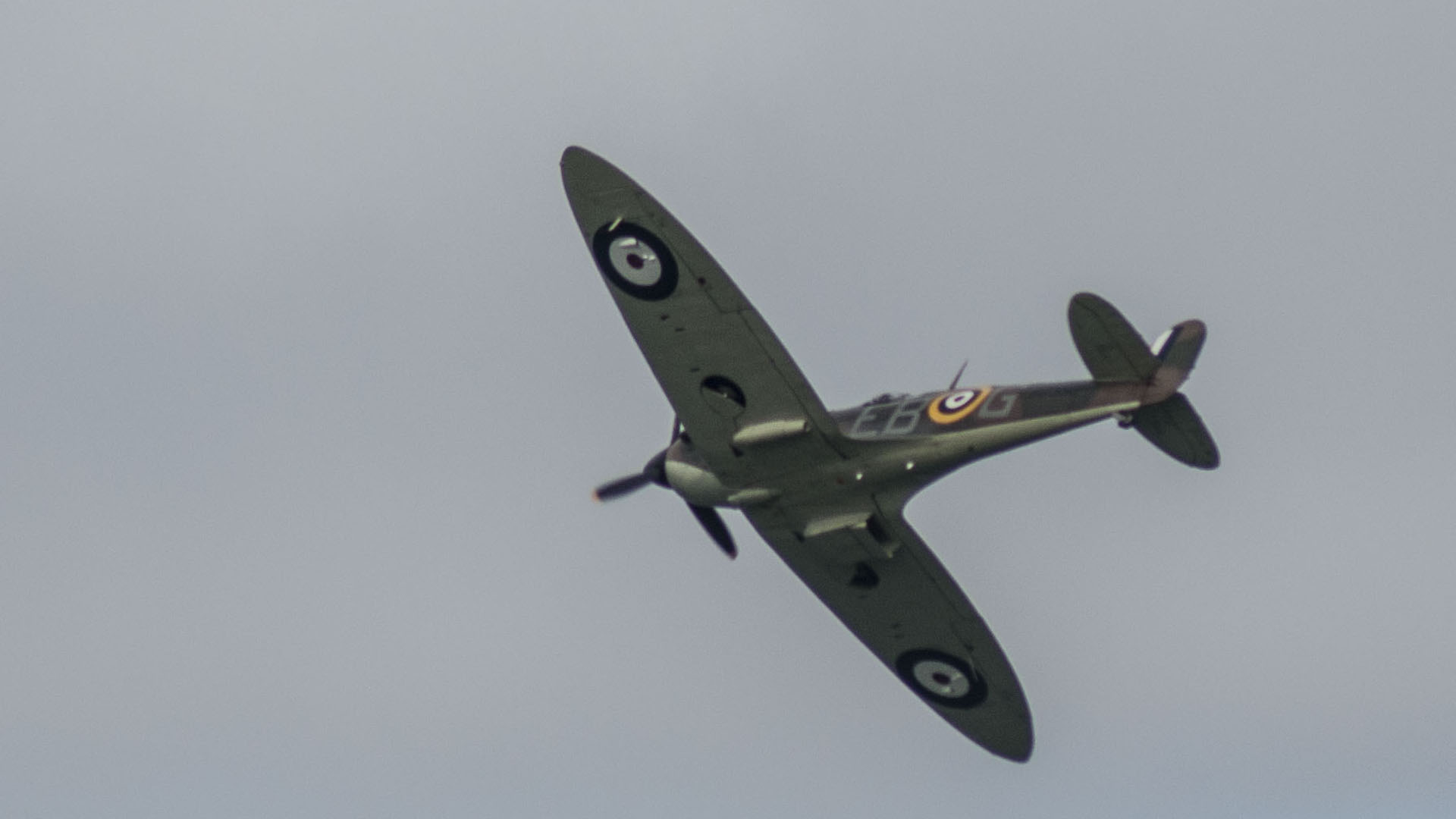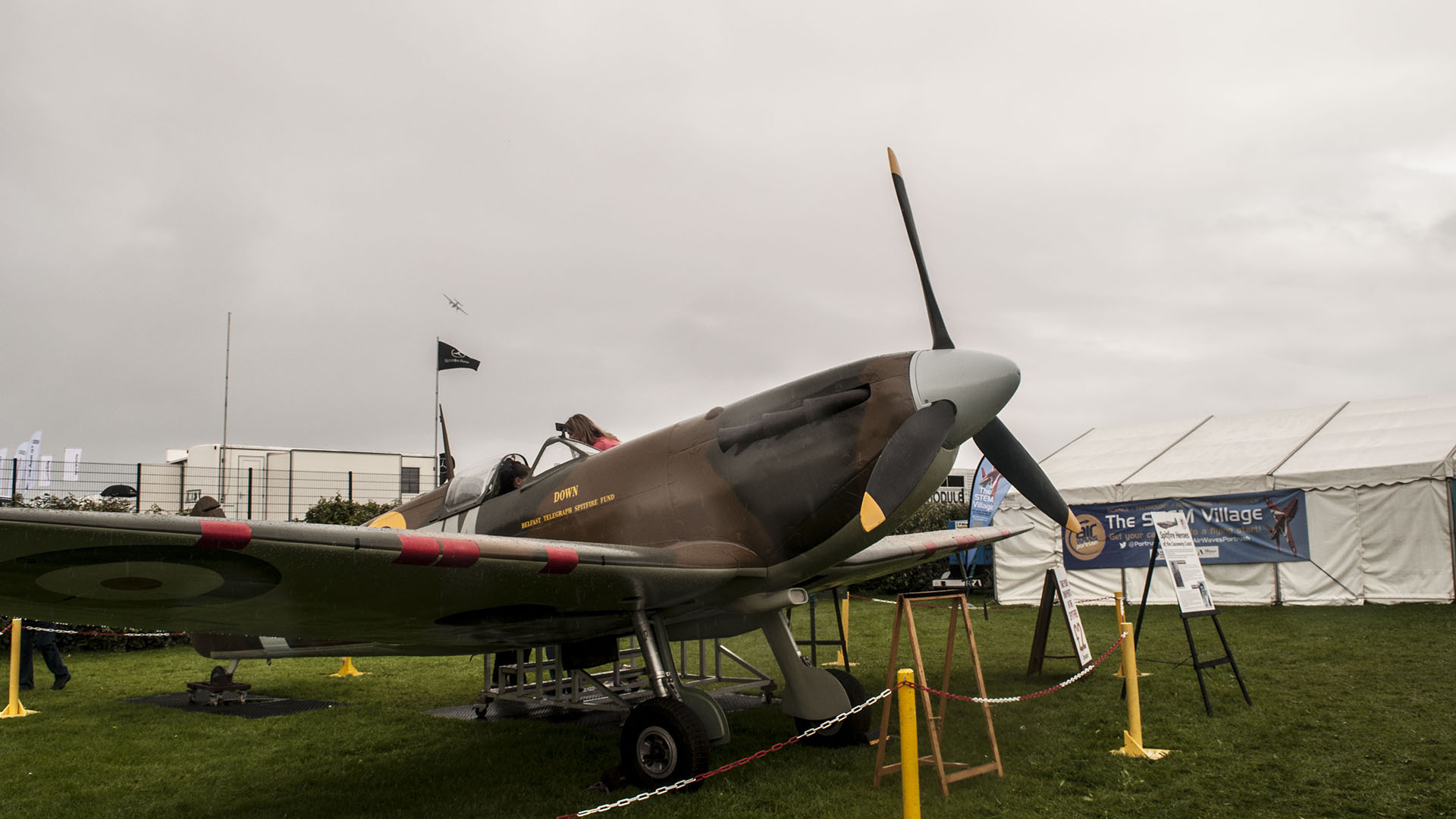RAF Long Kesh was a former military air force base at Maze, near Lisburn, Co. Down. Lying 16 kilometres southwest of Belfast, locals referred to the site as "Halftown".
During World War Two, various planes operated from the site. These included the Supermarine Seafire and the famous Supermarine Spitfire.
The Air Ministry planned Long Kesh and Maghaberry as stations for light and medium bomber planes. These plans dated back to the outbreak of war in September 1939 but construction on the boggy land was problematic. The air base cost an estimated £900,000 and was built by the Royal Engineers and H&J Marin contractors.
Short Brothers at Long Kesh
The Ministry of Aircraft Production constructed hangars for Short and Harland to use in the assembly of Stirling bombers. In August 1942, Shorts assembled their first Stirling bomber to be test-flown at Long Kesh. In 1943, production then moved to the nearby Maghaberry base leaving Long Kesh as a wing production site. Manufacturing continued at both Long Kesh and Maghaberry until 1945.
RAF Squadrons in NI
Flying at RAF Long Kesh began in October 1941. Several Royal Air Force squadrons arrived to provide support to army ground forces. This was an important role with the threat of airborne assault from Germany or a land invasion through neutral Ireland.
- 1941 – RAF 226 Squadron (Bristol Blenheim IV).
- 1941 – RAF 231 Squadron (Curtiss Tomahawk I and IIB).
- 1941 – RAF 88 Squadron (Douglas Boston III).
- 1941 – RAF 651 Squadron (Taylorcraft Auster).
RAF 226 Squadron in Bristol Blenheims arrived first, moving into the incomplete airbase. They were soon replaced by RAF 231 (Army Cooperation) Squadron in Westland Lysander and Curtiss Tomahawks. Their residency at Long Kesh did not last long either. Their replacement was RAF 88 Squadron in Douglas Bostons.
The German military viewed the airfield as having strategic significance, making it was a target of Operation Green. This operation was the planned second wave of German occupation following the Nazi’s Operation Sea Lion. While RAF Aldergrove, RAF Nutts Corner, and RAF Langford Lodge were to be held, Long Kesh was to be destroyed by elite German paratroopers. The airfield at RAF Long Kesh officially opened in November 1941.
Spitfires in the Co. Down sky
In December 1941, 1494 (Target Towing) Flight formed at RAF Long Kesh. Operating in Fighter Command, they provided air gunnery refresher training for crews in Northern Ireland.
By 1942, the threat of German invasion had dissipated. RAF Long Kesh and Maghaberry took on different roles for the remainder of the conflict.
- 1942 – RAF 74 Squadron (Supermarine Spitfire).
- 1942 – US Navy (Lockheed Electra).
In February and March 1942, RAF 74 (Fighter) Squadron operated from the Co. Down airfield. Flying Spitfires, they escorted US Army convoys and troop ships as they brought GIs to Northern Ireland. These Spitfires were fitted with long-range fuel tanks to help cover the Atlantic coast. With 74 Squadron’s departure, Long Kesh became a stopping off point for the US Navy and the RAF.
The Americans are coming
The US Navy flew three times per week between RAF Hendon, near London and RNAS Eglinton, Co. Londonderry. Long Kesh was a station where they would leave or collect passengers, freight, and mail in Lockheed Electras. 1st August 1942 onwards also saw the RAF use Long Kesh as a terminus for its towed glider, troop-carrying flights from Netheravon, Wiltshire.
On 8th September 1942, United States 8th Air Force Composite Command arrived. Their stay at the airfield lasted until November 1942. They then moved six miles away to Kircassock House, Moira, Co. Down.
From December 1942, RAF Coastal Command 17 Group operated from RAF Long Kesh. No 5 Operational Training Unit operated from Maghaberry until August 1943 and remained at Long Kesh until February 1944. No 5 OTU trained crews in maritime operations and first flew Beaufort, then Hampden, Hudson, Ventura, and Oxford planes.
RAF No. 5 Operational Training Unit
While No 5 OTU flew from RAF Long Kesh, there were many fatal accidents. Many of Northern Ireland’s airfields were surrounded by high ground. The rate of incidents in Beauforts reached a scale where the RAF grounded them for review. The Hampden aircraft of 5 OTU were much more reliable. They were the early plane of choice for Bomber Command but were phased out in favour of heavier Halifax and Lancaster bombers.
A memorial window in Eglantine Church pays tribute to the men of the RAF. Several men are laid to rest in the church cemetery.
Maintenance Unit at Long Kesh
By the end of 1942, 23 Maintenance Unit based at RAF Aldergrove made use of RAF Logn Kesh. They used the airfield and hangars to store and scrap equipment no longer in use including Stirling Bombers.
- 1943 – RAF 290 Squadron (Miles Martinet).
RAF 290 Squadron was the only other flying unit based at Long Kesh in 1944. They provided target towing facilities for training anti-aircraft gunners, flying in Airspeed Oxford and Miles Martinet planes. They were in demand from the RAF, Army, Royal Navy and a USAAF gunnery school at Kilkeel in Co. Down. 290 Squadron operated from the Co. Down airfield from March 1944 until February 1945. After they transferred to Scotland, Long Kesh had no further flying units.
Royal Navy Fleet Air Arm Squadrons
At the same time, the site was used by several squadrons of the Royal Navy Fleet Air Arm. Based away from the aircraft carriers for short periods, they carried out exercises. These included manoeuvres with ground troops, and anti-shipping bombing practise over Lough Neagh and Strangford Lough.
882 Squadron Fleet Air Arm operated Grumman Wildcats at the Co. Down site between October and December 1944. On 24th December 1944, 19-year-old pilot Peter Lock’s Wildcat engine caught fire between Long Kesh and Lough Neagh. The pilot ditched in Portmore Lough and the plane settled on the lake bed.
Lock’s Wildcat is part of a restoration project by the Ulster Aviation Society based at the old Long Kesh site. They recovered the stricken plane in 1984 and the pilot, who survived the crash, has returned on occasion from Canada to watch the progress. On Thursday 18th May 2017, Ulster Aviation Society reported that Peter Lock passed away on 6th January 2017.
Important visitors to Long Kesh
On 17th July 1945, King George VI, the Queen, and Princess Elizabeth made their first airborne visit to Northern Ireland. They arrived at RAF Long Kesh on a three Dakotas from RAF Hendon. A visit from General Eisenhower came in August 1945. He landed in a Douglas C-47 with the Duke of Abercorn accompanying. On 13th September 1945, Field Marshal Montgomery landed in his personal Dakota KN628. He stayed in Northern Ireland for a few days.
Communications Flight of HQ RAF Northern Ireland flew from Long Kesh from September 1945. At the end of that year, they transferred to RAF Sydenham in Belfast. The airfield closed in early 1946 becoming a British Army REME vehicle depot until 1948.
Long Kesh after the war
The site at Maze was used as a Command Vehicle Park and a tented camp for the British Army as they arrived in Northern Ireland from 1969. It became Long Kesh Detention Centre in 1971. It was the site of the internment of suspected members of the Irish Republican Army. Surrounded by watchtowers and searchlights, it resembled a prisoner of war camp.
One hut is said to have been haunted by the ghost of an RAF airman in full 1940s uniform. In 1976, most structures were demolished and the infamous H-Blocks were built on the old hardstandings. The site became known as Her Majesty’s Prison Maze. Some traces of the old airfield remain although the history of the prison is more widely known than that of RAF Long Kesh.
Memories of the old RAF airfield are kept alive by the Ulster Aviation Society who are based in two of the existing World War Two hangars. They boast an impressive collection of aircraft and assorted memorabilia including the “Down” Spitfire.


